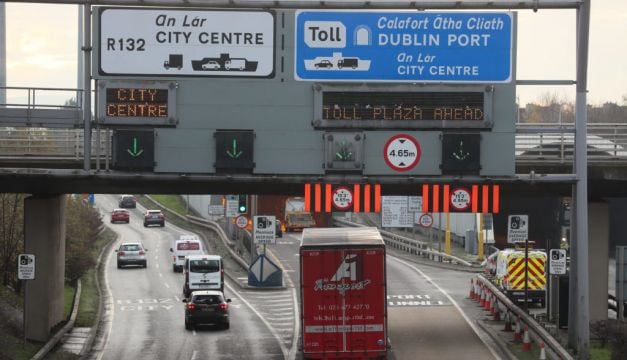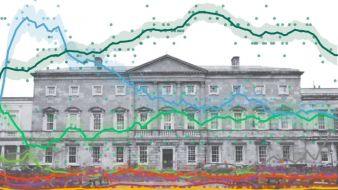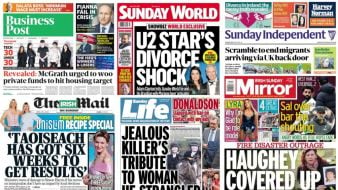The economic cost of congestion in the Greater Dublin Area is set to increase over four-fold from an estimated €336 million last year to more than €1.5 billion by 2040, according to a new report published by the Department of Transport.
It warns that congestion will increase significantly over the coming decades within Dublin and its commuter belt due to an increase in population and economic growth.
Two recent reports by TomTom and Inrix have separately ranked Dublin as the third and 12th most congested city in the world respectively.
Although investment in transport infrastructure planned over the next two decades, such as the BusConnects programme, will result in a reduction in the rate of increase in the cost of congestion, the department’s report said it will not be sufficient on its own to lower levels of traffic congestion which will continue to deteriorate.
However, the rate of increase will also differ widely between users of different transport modes.
The results show the cost of congestion will grow for private cars and goods vehicles by 217 per cent and 666 per cent respectively by 2040. The figure for bus users is considerably less, at only 98 per cent over the same period.
The report comes just weeks after Dublin City Council's transport chief, Brendan O'Brien, informed councillors he was not in favour of introducing congestion charges in the city.
Mr O'Brien said he did not believe “at the moment that congestion charging is a suitable tool in Dublin”.
Population growth
The report by the department’s Strategic Research and Analysis Division referred to the results of the 2022 Census, which showed significant growth in the Greater Dublin Area (GDA), with the populations of Meath, Kildare and Wicklow increasing by 12.9 per cent, 11 per cent and 9.2 per cent respectively since 2016.
It also observed that traffic volumes along the entire M50 road network have increased by an average of almost 10 per cent over the past decade.
The annual average daily traffic on the M50 in 2022 was 106,000 – just down from its pre-pandemic level of just under 110,000 in 2019.
The report said there had also been a significant increase in active travel journeys, such as walking and cycling, between 2012 and 2021, with such modes increasing from 21.9 per cent to 29.5 per cent over the period.
Although the figures suggest there has been a decrease in the reliance on private cars, they are still the primary mode of transport for almost six out of every 10 journeys.
While there was also an increase in numbers using public transport, they still only account for one in eight journeys.
“Congestion will remain a challenge given the high reliance on private vehicles in the GDA to complete journeys,” the report observed.
However, it also examined the impact of alternative scenarios, such as increased working from home as a result of the Covid-19 pandemic.
It found that it resulted in congestion costs falling by €73 million (22 per cent) in 2022. By 2040, it would lead to a 9 per cent drop, with the cost of congestion decreasing by €100 million to €1.4 billion.
Behaviour changes
The department said such a finding demonstrated that behavioural-change interventions can have a significant impact on reducing the cost of congestion.
The report also indicated there is an increasing concentration of congestion in more urban areas.
The cost of congestion within the canals and also in the area between the canals and the M50 is set to increase significantly from now to 2040.
It predicted that congestion will be particularly acute in hot-spots, such as the Liffey quays, and on key arterial routes such as the M50.
The report shows that traffic flows slow down considerably when roads reach 80 per cent or more of their capacity.
Costs are estimated on the basis of delay and the value of travel time, which reflects the economic impact of congestion on individuals and society.
Congestion is also associated with several other negative impacts, including greenhouse gas emissions and local air pollution, although the report did not provide cost estimates for such factors.
For that reason, it claimed the real cost of congestion to Irish society is likely to be significantly higher than its estimates.
The report also highlighted that some policies which have been extremely successful in alleviating congestion, such as the re-routing of heavy goods vehicles away from Dublin city centre via the Dublin Port Tunnel, have nevertheless resulted in an increase in greenhouse gas emissions and local air pollution across the city as a whole due to longer travel distances for vehicles.
It claimed such a finding highlighted how there is “not one silver bullet to address congestion”, adding that tackling congestion is complex and would require a range of policy measures.
It observed that the strong rebound in transport levels in 2021-2022 demonstrated the clear link between economic growth and activity in the transport sector. However, the report said it underscored the need to decouple transport demand from economic growth.
It noted that the TomTom study estimated that the average motorist in Dublin spends 145 hours annually in traffic due to congestion – more than double the amount of time spent by drivers in cities with roughly similar populations, such as Vienna, Birmingham, Glasgow, Copenhagen, Cologne and Amsterdam.
The latest study follows on from a similar report from 2017 which estimated the cost of congestion in the Greater Dublin Area in 2012 was €358 million, rising to €2.08 billion by 2033.
However, the department said the results from the 2017 study were not directly comparable with the latest figures due to different methodologies used to calculate cost estimates.







